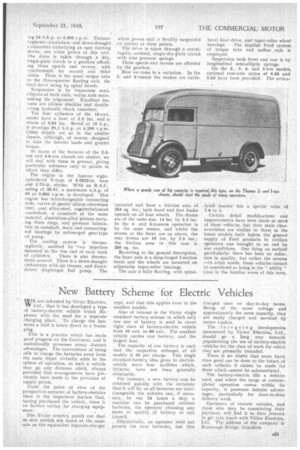New Battery Scheme "for Electric Vehicles
Page 23

If you've noticed an error in this article please click here to report it so we can fix it.
WE are informed by Victor Electrics, Ltd., that it has developed-a type of battery-electric vehicle which dispenses withthe need for a separate charging plant. To charge the batteries a lead is taken dittect to a heater plug.
This is a practice which has made good progreas on the Continent, and it undoubtedly .possesses many distinct advantages. The convenience of being able to charge the batteries away from the main depot virtually adds to the sphere of operation, as such a vehicle may go any distance afield, always provided that arrangements have pre-. viously been made in the provision of supply points.
Fromthe point of view of the -prospective operator of battery-electrics there is the important feature that, having purchased the vehicle, there is no further outlay for charging equipment,
The Victor concern points out that As new models are taxed at the same rate as the equivalent separate-charger type, and that this applies even to the smallest models.
Also of interest is the Victor single standard battery scheme in which only one size of battery is used to cover eight sizes of battery-electric vehicle from 10 cwt. to 80 cwt. The smallest vehicle carries one battery, and the largest four.
The capacity of one battery is such that the respective mileages of all models is 50 per charge. This single standard-battery idea gives to electric. vehicle users four facilities which, hitherto', have not been generally obtainable.
For instance,a new battery can be obtained quickly with the certainty that it will fit; as all batteries are interchangeable the vehicles can, if necessary, be run 24 hours a day; a machine can be purchased without batteries, the operator choosing any make or quality. of battery to suit
himself. , • „ Alternatively, an operator need not possess his own batteries, but hire
charged ones on day-to-day terms. Being of -the same voltage and approximately the same capacity, they are easily charged and serviced by motor traders.
The foreo ° oing developments announced by Victor Electrics, Ltd., should go a long way towards popularizing the use of battery-electric vehicles for the class of work for which they are primarily intended.
There is no doubt that more harm than good can be done' to the future of such vehicles if claims be made for them which cannot be substantiated.
The battery-electric fills a definite need, and where the range of contemplated operation comes within its capacity, it possesses definite advantages, particularly for door-to-door delivery work.
Operators of electric vehicles, and those who may be considering their phrchase, will .find it to their ,interest to get into touch with Victor Electrics, Ltd.. The address of the company is Burscough Bridge, Ormskirk.




















































